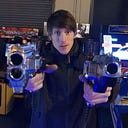Game Retrospective: Ristar

On the 16th of February 1995, Ristar was first released for the Sega Genesis/Mega Drive in North America. The game would launch in Japan, Europe and Australia over the next three consecutive days.
Developed by Sega, the game’s development team were led by Akira Nishino, a young Sega employee who had previously worked as a designer on Sonic the Hedgehog CD. The game would be the first major project of Yuji Uekawa, an artist widely credited as the designer of the Ristar character. Following the release of Sonic R for the Sega Saturn in 1997, Uekawa would become the Sonic the Hedgehog series lead character designer.

Although some sources credit Sonic Team with the game’s development, the studio actually receives no such mention in the game’s credits. In a December 1994 interview in Electronic Gaming Monthly, two representatives from Sega’s marketing team would discredit this further. When asked whether the original Sonic programming team contributed in any way, referring to similarities with the two games, they replied with, “No, it wasn’t designed by the same development team.” Many of the Ristar staff would, however, later work on the Sonic Team title, Nights into Dreams.
The game follows the central character, Ristar (an anthropomorphic shooting star) as he ventures across the Valdi System, in an effort to defeat the evil Kaiser Greedy, a power-hungry dictator who has enslaved the entire system, using mind control to manipulate the leaders of each planet. While traversing the game’s environments, Ristar uses his arms to climb walls, swing across tree branches and ride spinners, as well as attack enemies by grabbing and head-butting them, a technique that can also be used to smash open treasure chests. Ristar’s story differs between Japanese and Western releases of the game. While the Japanese version has Ristar being awakened and tasked in his mission by the Star Goddess, Oruto, the Western release removes the character of Oruto altogether and instead has Ristar embarking upon a quest to rescue the ‘Legendary Hero’, a father-figure to Ristar, who has been kidnapped by Greedy.

The origins of Ristar can be traced back to 1990, when Sega of Japan president, Hayao Nakayama, decided the company needed a new mascot to compete with Nintendo’s Mario. Although the character of Alex Kidd had briefly held this role, his design was ultimately considered too similar to Mario and an internal design competition was soon held. Numerous concepts for potential mascots were submitted, one of which was a rabbit. When asked about the creation of the Sonic character, during a September 1992 interview with Sega Visions magazine, Sonic the Hedgehog lead programmer, Yuji Naka, remarked, “At first we used a character that looked like a rabbit with ears that could extend and pick up objects.” Although this design came close, Naka went on to explain that it was eventually dropped as the game became faster and a spinning technique was adopted, leading to the character becoming hedgehog, eventually called Sonic.
Years later, as the 16-bit Mega Drive was nearing the end of its lifespan, despite at this time now boasting a vast library of character-based platformer titles, Sega commissioned the development of yet another for the ageing console. In a video interview featured in the 2009 Sega Mega Drive Ultimate Collection, Akira Nishino stated, “We somehow had to develop at least one more cartoon action game, and this was a priority.” Wanting their game to offer something completely different, Nishino and his team played through countless existing titles to identify a potential unique core mechanic. Revisiting the earlier rabbit design, they eventually settled upon a character that could reach out and feel it’s surroundings.

The design of the character altered significantly as development progressed. The ‘feeling’ mechanic was seen by Nishino as directly mimicking the curious nature of a child, leading to the suggestion that the main character should also be a child. The first shared redesign of the character appeared in several preview screenshots for a prototype called ‘Feel’. Rather than using his ears, the character now used his arms and bore very little resemblance to a rabbit. The character would also undergo several name changes, with one prototype referring to the character as ‘Dexstar’, while some unearthed game code even suggested his name was going to be ‘Volt’ at one point.
Upon release, Ristar received praise for its striking visuals, solid gameplay and catchy music, and would go on to amass numerous positive review scores. However, some critics would comment on the game’s lack of originality, believing it to be too similar to titles such as Sonic the Hedgehog and Dynamite Headdy.

Unfortunately, Ristar received little exposure at the time of its release. Gamers were readying themselves for the next generation of consoles, and even Sega themselves would release the successor to the Genesis, the Saturn, just three months later. Over time, appreciation of the game has grown, with the character receiving cameos in Shenmue, Segagaga and Sonic & Sega All-Stars Racing, as well as countless Sega compilation releases.
🕹Are you a fan of Ristar? Would you welcome a sequel? Do you feel the character can make a comeback? Which are your favourite platformers on the Mega Drive/Genesis?🕹
